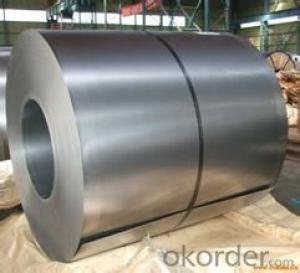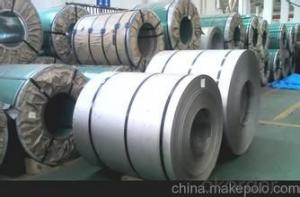excellent cold rolled steel coil / sheet -SPCCT
- Loading Port:
- China main port
- Payment Terms:
- TT OR LC
- Min Order Qty:
- 30 m.t.
- Supply Capability:
- 5000000 m.t./month
OKorder Service Pledge
OKorder Financial Service
You Might Also Like
Characteristics:
1. Commercial quality suitable for bending fabrication and simple forming; this is the type in greatest demand.
2. Drawing quality second only to that of SPCEN. Excellent uniformity.
3. Deep-drawing quality.With metallurgically controlled grain size, it retains its beautiful finish even after being deep-drawn.
4. Extra-low-carbon steel sheets with highest workability
General Application of Cold Rolled Steel Coil:
1. Refrigerators, cabinets, power distribution baords and drums.
2. Automobile floor and roof panels.
3. Automobile fenders and quarter panels
4. Automobile fenders and quarter panels
Quality of the goods could be guaranteed. The finished product has a variety of excellent capabilities, such as continuous rolling, degreasing, annealing, skin pass, slitting and cut to length line etc. Along with it many rocessing capability and smooth, flat surface. It’s widely used in outdoor and interior decoration, furnishing
- Q:What are the common surface treatments for steel coils?
- Common surface treatments for steel coils include galvanizing, which involves applying a layer of zinc to protect against corrosion; painting, where a layer of paint is applied for aesthetic purposes or to provide additional protection; and chromating, which involves applying a thin layer of chromium to enhance corrosion resistance and improve paint adhesion.
- Q:How do you calculate the weight of a steel coil?
- In order to determine the weight of a steel coil, one must have knowledge of its dimensions and the specific gravity of the steel. The weight can be calculated using the following formula: Weight of steel coil = Length of coil (in meters) x Width of coil (in meters) x Thickness of coil (in meters) x Specific gravity of steel To begin, measure the length, width, and thickness of the steel coil in meters. It is important to ensure that all measurements are in the same unit in order to obtain accurate calculations. Next, find the specific gravity of the steel. The specific gravity is the ratio of the density of the substance to the density of water. For steel, the specific gravity is typically around 7.8. Multiply the length, width, and thickness of the coil together. This calculation will provide the volume of the steel coil in cubic meters. Lastly, multiply the volume of the coil by the specific gravity of steel to obtain the weight of the steel coil in kilograms (kg). Please note that this calculation only accounts for the weight of the steel coil and does not consider any additional factors such as the core material or any other components included in the coil.
- Q:Will a 8mm steel ball fired from a 150lbs crossbow kill small game and if so, from how many yards?
- An 8mm steel ball fired from a 150# crossbow is probably going to damage your crossbow. Crossbows shoot arrows (or bolts), NOT ball bearings and, furthermore, a 150# crossbow needs an arrow (or bolt) of about 450 grains in order to be efficient and operate without damaging itself. A 450 grain arrow will kill small game very well and out to a range of about 30 yards. Don't wind up like the guy below... EDIT: Racing Pace Stick - I stand corrected. There are, indeed, tacticool crossbows that shoot ball bearings and they all seem to come straight from Shandong Province, China. Note that these are not implements suited to hunting. Also note that if you shoot an 8mm steel ball out of a 150# draw compound crossbow that IS suitable for hunting, you are probably going to break it.
- Q:What are the safety considerations when handling steel coils?
- When handling steel coils, it is important to consider safety measures to prevent accidents or injuries. Some key safety considerations include: 1. Proper training: All personnel involved in handling steel coils should receive adequate training to understand the risks associated with the task and learn proper handling techniques. 2. Personal protective equipment (PPE): Workers should wear appropriate PPE such as gloves, safety boots, and eye protection to protect against cuts, punctures, or other injuries. 3. Load capacity and stability: Ensuring that lifting equipment and machinery used for handling steel coils have the necessary load capacity and stability is crucial to prevent accidents or equipment failures. 4. Proper lifting techniques: Using correct lifting techniques, such as bending the knees and lifting with the legs rather than the back, helps to minimize the risk of strains or back injuries. 5. Secure storage: Steel coils should be stored in a secure and organized manner, with proper blocking, bracing, or racking systems in place to prevent them from shifting or falling. 6. Inspection and maintenance: Regular inspection of lifting equipment, hooks, slings, and other accessories is essential to identify any signs of wear or damage that could compromise safety. 7. Communication and coordination: Establishing clear communication protocols and coordination among workers involved in handling steel coils can help prevent accidents, especially in areas with limited visibility or restricted access. 8. Hazard identification and mitigation: Identifying potential hazards such as sharp edges, loose straps, or uneven surfaces, and taking appropriate measures to mitigate these risks, is vital to ensure safe handling practices. By considering these safety measures, the risk of accidents or injuries associated with handling steel coils can be significantly reduced.
- Q:I'm a Hobbyist and want to Build my own axial-flow jet engine,can I use steel as the Turbine blades instead of Titanium which I can't get easily?? What about the other parts I can use for...?!
- You can use steel but alloyed with a big percent of Mn and Cr. Titanium is very good but unfortunately it is expensive. On engines and Turbine blades it is indicate to use High Alloy metals that are resistant to fluage.
- Q:i am working a client.my vendor specified in pipe specification pipe line class as MS1 (code for Mild steel)but assigned material to this code is cs smls astm A 106B.my question is any difference between CS and MS material?pls suggest me
- The terms mild steel and carbon steel are general terms and do not refer to a specific grade of steel. If your client asked for A106B then that is what you need to ask your vendor to quote you. If MS1 references A106B then again, that is what you get prices for.
- Q:What is the (balanced) chemical equation for steel?
- I hate to differ but I must. Steel is a mixture of iron and carbon but the carbon content ranges from a small fraction of a percent to no more than 2%. Stainless steel is an alloy of Iron and up to 15% or so of other metals but since there are several types and many varieties in each type it's hardly worth getting into. A good common hardenable high-carbon spring steel is AISI 1095. In this code the 95 refers to 0.95% carbon. When the carbon level goes up to 1.5% to 2% the steel is very brittle and black with the highest carbon steel being pretty much pig-iron.
- Q:We have a stain from a pot or bowl in our new expensive stainless steel sink. It looks like a water mark that happens when you leave a glass on a table without a coaster. It's a mark in the shape of the bowl or pot that was there. We left it there overnight:( It's not rust either. Help!
- in your super market their is a pad that is green and is called scooth bright use it on the stain and it will remve it
- Q:I need to identify a metal. It is rusty so I suspect it is either iron or steel. Since they both have similar densities and are magnetic, how do I tell the difference betweeen steel and iron?
- Iron and Steel Manufacture, technology related to the production of iron and its alloys, particularly those containing a small percentage of carbon. The differences between the various types of iron and steel are sometimes confusing because of the nomenclature used. Steel in general is an alloy of iron and carbon, often with an admixture of other elements. Some alloys that are commercially called irons contain more carbon than commercial steels. Open-hearth iron and wrought iron contain only a few hundredths of 1 percent of carbon. Steels of various types contain from 0.04 percent to 2.25 percent of carbon. Cast iron, malleable cast iron, and pig iron contain amounts of carbon varying from 2 to 4 percent. A special form of malleable iron, containing virtually no carbon, is known as white-heart malleable iron. A special group of iron alloys, known as ferroalloys, is used in the manufacture of iron and steel alloys; they contain from 20 to 80 percent of an alloying element, such as manganese, silicon, or chromium.
- Q:What is the standard thickness of steel coils?
- The standard thickness of steel coils can vary depending on the specific application and industry. However, common thickness ranges for steel coils typically fall between 0.015 inches (0.38 mm) and 0.125 inches (3.17 mm).
1. Manufacturer Overview |
|
|---|---|
| Location | |
| Year Established | |
| Annual Output Value | |
| Main Markets | |
| Company Certifications | |
2. Manufacturer Certificates |
|
|---|---|
| a) Certification Name | |
| Range | |
| Reference | |
| Validity Period | |
3. Manufacturer Capability |
|
|---|---|
| a)Trade Capacity | |
| Nearest Port | |
| Export Percentage | |
| No.of Employees in Trade Department | |
| Language Spoken: | |
| b)Factory Information | |
| Factory Size: | |
| No. of Production Lines | |
| Contract Manufacturing | |
| Product Price Range | |
Send your message to us
excellent cold rolled steel coil / sheet -SPCCT
- Loading Port:
- China main port
- Payment Terms:
- TT OR LC
- Min Order Qty:
- 30 m.t.
- Supply Capability:
- 5000000 m.t./month
OKorder Service Pledge
OKorder Financial Service
Similar products
New products
Hot products
Related keywords






























